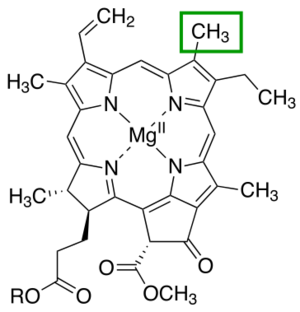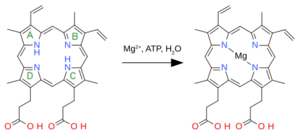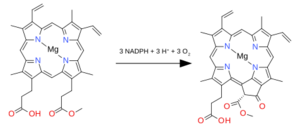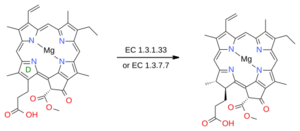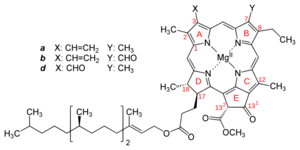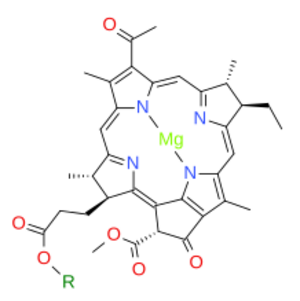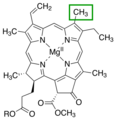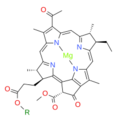Chlorophyllide facts for kids
Chlorophyllide a and chlorophyllide b are important building blocks that plants, algae, and cyanobacteria use to make chlorophyll a and chlorophyll b. Chlorophyll is the green stuff that helps plants turn sunlight into energy (a process called photosynthesis).
These chlorophyllides are changed by a special helper molecule called chlorophyll synthase. This helper adds a part called a phytol ester to them. Chlorophyllide a is also a step in making other similar substances called bacteriochlorophylls, which are found in some types of bacteria.
Contents
What are Chlorophyllides?
Chlorophyllide a is a type of carboxylic acid. Think of it as a molecule with a specific chemical structure. Chlorophyllide b is very similar, but it has a small difference: a methyl group (a carbon and three hydrogen atoms) in chlorophyllide a is swapped for a formyl group (a carbon, hydrogen, and oxygen atom) in chlorophyllide b. This small change makes them slightly different and gives them different roles.
How Chlorophyllides are Made
Making chlorophyllides is a long process with many steps. It starts with a simple substance called glutamic acid.
Early Steps: From Simple Molecules to Protoporphyrin IX
The first steps involve many changes to the starting molecules. Special helpers called enzymes transform simple molecules into a ring-shaped molecule called uroporphyrinogen III. This molecule is a key building block for many important things in living organisms, like the substance that helps blood carry oxygen (heme) and chlorophyll itself.
After more changes, this molecule becomes protoporphyrin IX. This is a very important step! In animals, iron is added to protoporphyrin IX to make haem, which helps blood carry oxygen. But in plants, magnesium is added instead. This magnesium-containing molecule then goes through more changes to become chlorophyll, which is essential for photosynthesis.
Adding Magnesium
Chlorophyll has a magnesium atom right in its center. This magnesium is added to protoporphyrin IX by an enzyme called magnesium chelatase. This process uses energy from a molecule called ATP.
Changing a Side Chain
Next, a small part of the molecule, called a propionate group, gets a methyl group (CH3) added to it. This change is done by an enzyme called magnesium protoporphyrin IX methyltransferase.
Forming the Chlorin Ring
The special ring system found in chlorophyll, called a chlorin, is formed in the next step. One of the side chains of the molecule curls around and connects to another part of the main ring. This creates a new five-sided carbon ring. This complex change is helped by an enzyme called Magnesium-protoporphyrin IX monomethyl ester (oxidative) cyclase.
Becoming Chlorophyllide a
To finally make chlorophyllide a, two more changes are needed. Both are reduction reactions, which means hydrogen atoms are added. One reaction changes a vinyl group (a specific chemical part) into an ethyl group. The enzyme divinyl chlorophyllide a 8-vinyl-reductase helps with this.
The second reaction adds two hydrogen atoms to one of the pyrrole rings (Ring D) of the molecule. This step is done by the enzyme protochlorophyllide reductase. This reaction usually needs light to happen. However, some organisms have another enzyme that can do this in the dark.
From Chlorophyllide a to Chlorophyllide b
Chlorophyllide a can be changed into chlorophyllide b by an enzyme called Chlorophyllide-a oxygenase. This enzyme uses oxygen and other molecules to make the change.
Using Chlorophyllides to Make Chlorophylls
The final step in making chlorophyll a is done by the enzyme chlorophyll synthase. This enzyme takes chlorophyllide a and adds a long chain molecule called phytol to it. This creates the complete chlorophyll a molecule.
Chlorophyll b is made in the same way, but it starts with chlorophyllide b. Other types of chlorophyll, like chlorophyll d and f, are also made from their own chlorophyllide versions, which all come from chlorophyllide a.
Using Chlorophyllides to Make Bacteriochlorophylls
Bacteriochlorophylls are like chlorophyll but are found in photosynthetic bacteria. They help these bacteria capture light energy, but they don't produce oxygen like plants do. Many different types of bacteriochlorophylls exist, and they all start from chlorophyllide a.
Making Bacteriochlorophyllide a
One common type is bacteriochlorophyll a. The first step to make it is to change one of the rings (pyrrole ring B) of chlorophyllide a. This is done by the enzyme chlorophyllide a reductase.
Then, two more steps change a specific part of the molecule (a vinyl group) into a 1-hydroxyethyl group, and then into an acetyl group. These changes are helped by enzymes called chlorophyllide a 31-hydratase and bacteriochlorophyllide a dehydrogenase.
Once bacteriochlorophyllide a is formed, it's ready to have other parts added to it to become the final light-capturing pigments used by bacteria for photosynthesis.
Images for kids



